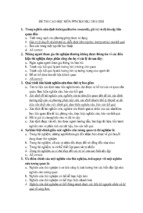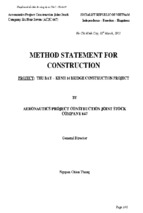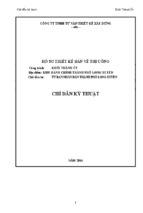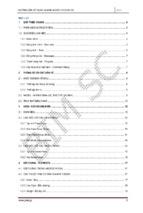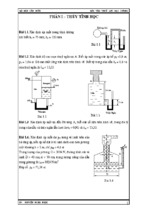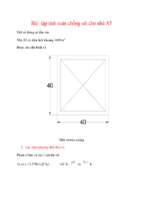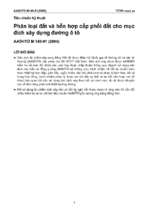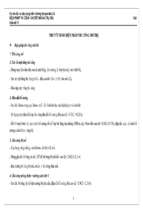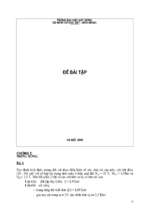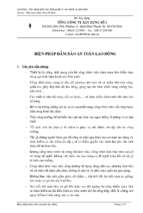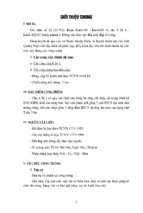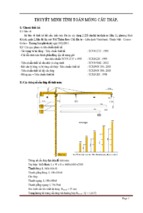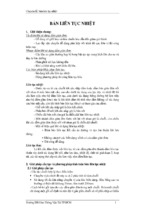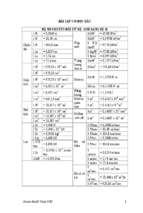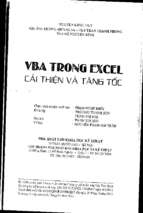1
Planning Site Investigations
J.H.BUNGEY
Department of Civil Engineering,
University of Liverpool, UK
1.1 INTRODUCTION
On-site investigation of concrete bridges may be necessary for a wide range
of reasons which will generally be associated with assessment of either
specification compliance, maintenance requirements or structural adequacy.
Establishing the precise aims of inspection and testing is an essential
prerequisite to all test programme planning including fundamental aspects
such as selection of methods, location of test points and interpretation of
results. On-site inspection and testing, other than superficial visual
inspection, is seldom cheap as complex access arrangements are frequently
necessary and procedures may be time-consuming. Furthermore, individual
observations or test results are often inconclusive, and back-up testing
coupled with considerable engineering judgement and experience are then
required.
The importance of careful planning cannot be overemphasised, if the
maximum amount of worthwhile information is to be obtained at minimum
cost. Ideally, a programme should be planned to evolve sequentially, as
illustrated in Fig. 1.1, in the light of results obtained in its earlier stages and
using only those stages necessary to achieve conclusions with an adequate
degree of confidence. Although it is recognised that this may sometimes pose
financial difficulties in that the cost will not be clearly defined at the outset,
there is little doubt that this will generally provide the most cost-effective
approach. It should also be noted that objectives, as originally defined, may
Copyright 1987 Elsevier Applied Science Publishers Ltd.
Fig. 1.1. Stages of investigation.
Copyright 1987 Elsevier Applied Science Publishers Ltd.
change in the course of an investigation, possibly as the result of litigation, and
both planning and documentation should attempt to bear this eventuality in
mind. A further component of a successful site investigation is that full agreement
is reached between all parties involved concerning the interpretation of results
before any testing commences. This is essential if future disputes about the
significance of results are to be avoided.
Relevant testing methods and equipment are described in Chapter 2, to which
reference should be made for further detailed sources of information about
individual techniques.
1.2 TYPES OF INVESTIGATION
1.2.1 Specification Compliance
Determination of compliance of concrete bridges with their specification is
primarily undertaken during, or soon after, construction, and only
exceptionally will such testing be required at later stages in the life of a
structure.
1.2.1.1 Routine Testing at Time of Construction
This will consist, in part, of quality control testing of materials, which usually
utilises representative samples of the materials to be used. In the case of
concrete, however, the ‘standard’ 28-day compressive strength specimen in
the form of a cube or cylinder cannot take account of the levels of compaction
or curing received by the concrete in the structure. Furthermore, the limited
number of samples for this purpose, or for ‘fresh’ properties such as
workability or air content, which are normally associated with an individual
pour cannot ever truly reflect variations of the material actually used, even if
samples are taken according to a very well controlled plan. There is a growing
awareness in some parts of the world (notably the USA and Scandinavia) of
the benefits of physical control testing of the in-situ concrete, in addition to
standard specimens. Appropriate non-destructive methods for this type of
investigation include pull-out, penetration resistance, break-off, and
ultrasonic pulse velocity surveys.
The other principal aspects of ‘investigation’ at early ages of a structure are
essentially visual, concentrating on line, level and surface appearance of the
concrete following formwork removal. Unfortunately this gives little indication
of the likely performance of the structure since interior defects, including incorrect
positioning or displacement of reinforcement, cannot be seen. In view of the
numerous reported cases of inadequate thickness of concrete cover and the
Copyright 1987 Elsevier Applied Science Publishers Ltd.
subsequent effects of this upon long term durability, there is a very strong case
for measurement of cover as a matter of routine following removal of formwork
to ensure that specified thicknesses have been provided. Such testing is quick
and straightforward, adding little to the cost of a project and yet potentially
offering significant long term advantages to a client.
Other tests which are available include analysis of the fresh concrete to
determine cement content, and surface absorption measurements; however,
neither of these approaches is currently applied to bridge construction in the
United Kingdom as a matter of routine. It is of interest to note, however, that
specifications in Denmark may call for microscopic thin-section analysis of
samples obtained from cores taken from newly cast concrete in order to confirm
cement type and content.
1.2.1.2 Non-routine Testing Following Construction
Such testing will normally arise from failure of ‘standard’ compression
specimens to achieve the required strength. Testing will thus be aimed at
confirming or disproving that suspect concrete is substandard, and if
necessary determining the extent of such material. It is in such situations
that the use of comparative non-destructive testing followed as necessary by
more expensive and disruptive techniques, as outlined in Fig. 1.1, is of
greatest value.
Tests of concrete strength, of which core tests are the most reliable, are
able to assess the actual in-situ value at a given location to within 95%
confidence limits of
where n samples are tested.1 Whilst this may
appear to be very useful, uncertainties concerning the relationship between
actual in-situ strength and that of ‘standard’ specimens (sometimes referred
to as ‘potential’ strength) complicate interpretation. Marginal cases are thus
difficult to prove or disprove with any degree of certainty.
It is essential that such testing is designed to obtain results relating to
‘average’ conditions within the suspect part of the structure whilst
recognising the likely variations and level of in-situ properties appropriate to
the particular member type, as discussed later. Locations of tests for this
purpose will thus not necessarily correspond with those which may be
required to determine structural adequacy, and it is important that this feature
of test planning is recognised.
1.2.1.3 Testing at Later Stages
Testing of this type will usually result from abnormal deterioration being
observed in the course of routine inspections, and will often be associated
with litigation. Chemical analysis or microscopic thin-section analysis of
Copyright 1987 Elsevier Applied Science Publishers Ltd.
appropriate samples taken from the in-situ concrete will frequently be used
to attempt to determine mix features such as cement type and content,
chloride or sulphate levels, entrained air content, or excessive admixture
dosage. In embarking upon a test programme for this purpose it is again
important to recognise the limits upon accuracy within which the desired
property can be assessed. 2 Normal material variability will mean that
extensive sampling may be required and it is usually only gross deficiencies
that may be identified with a sufficient degree of confidence to prove noncompliance with specification limits.
Tests of concrete in-situ strength will be subject to the problems of
interpretation indicated above, further aggravated by age and moisture
effects, and it will again usually only be possible to confidently
demonstrate non-compliance with strength specifications in cases of major
shortfall.
The other major testing approach within this category involves measurement
of the thickness of concrete cover to embedded reinforcement or prestressing
ducts. This can be quickly achieved non-destructively by the use of
electromagnetic cover measuring devices which are generally accurate to within
about ±5 mm when properly calibrated for the particular concrete and steel
characteristics. In this case, however, it is a simple matter to obtain conclusive
evidence about the adequacy of cover values by drilling or breaking out at
suspect areas identified by the non-destructive tests. This particular equipment
may also sometimes be useful to confirm the number and spacing of bars present
in cases where doubts exist.
1.2.2 Routine Inspection
The need for necessary remedial work to be undertaken in good time to prevent
more serious and costly structural deterioration is particularly acute in the case
of bridges. This is due to a combination of the exposure conditions to which
most bridges are subjected, leading to excalating deterioration rates, and the
severe social and commercial costs and consequences generally resulting from
closure or application of load restrictions. Economic maintenance is thus
heavily dependent upon regular and thorough inspection and monitoring to
detect deterioration at an early stage. It is important that such inspections are
programmed and executed in a systematic manner, and requirements relating
to motorway and trunk road bridges in the United Kingdom are set out in the
Department of Transport’s Standard BD22/84.3 This document identifies four
basic types of inspection.
Copyright 1987 Elsevier Applied Science Publishers Ltd.
1.2.2.1 Superficial Inspection
This should be an ongoing process, with staff encouraged to report any
obvious deficiencies which may lead to more serious long term problems or
loss of safety to the bridge users. Inspections of this type would include
features such as impact or flood damage and expansion joint deterioration.
Reports of such problems may also originate from bridge users, and it is
essential that procedures are established for reports to be followed up and
properly documented.
1.2.2.2 General Inspection
Representative parts of the structure should be inspected visually every
one or two years. This will not generally require any specialised access
equipment, although binoculars or telescopes may sometimes be useful
aids. Features to be observed will include deflections and distortions,
cracking, surface deterioration and leakage. The results of these
inspections should be made on standardised forms to simplify data
analysis and storage of inspection records, and this requires classification
of both the extent and severity of observed defects and an indication of
their likely cause. Inspectors are also required to give a repair priority
assessment and a cost estimate of each item of work identified.
1.2.2.3 Principal Inspections
These are required every six to ten years and represent a major
undertaking involving access equipment with possible lane closures and
railway track possessions. This inspection requires a close examination
of all inspectable parts of the structure and will be predominantly visual,
aided by devices such as crack-width microscopes and fibre-optic
equipment. Where defects are found, however, the subsequent detailed
investigation to assess their extent and cause may involve a wide range
of equipment. This may include assessment of features such as cover,
reinforcement corrosion, internal concrete integrity and defects, and
material properties. The results may possibly lead to an assessment of
structural adequacy as described below. Long term monitoring of
structures for crack development, settlement and subsidence may also
follow from such inspections.
Results of principal inspections are reported in a similar manner to those of
general inspections but in the case of initial inspections, or the first principal
inspection following radical structural changes, the report should be
supplemented by standardised details of construction of the structure to ensure
proper documentation for future use.
Copyright 1987 Elsevier Applied Science Publishers Ltd.
1.2.2.4 Special Inspections
Special inspections are necessary for bridges which are identified as being
subject to particular risk. In the case of concrete structures this includes
those which
(a)
(b)
(c)
(d)
exhibit a specific condition causing concern,
are subject to load restriction,
are at risk from subsidence in mining areas, or
are required to carry an abnormal load which exceeds that
already documented or is likely to induce critical stresses.
Other cases requiring special inspection include those where excessive
settlement is observed, following major fires under structures, and following
possible flood damage to foundations.
The nature of special inspections will vary widely according to their
purpose. They may make use of a wide range of the testing techniques described
in Chapter 2 and may lead to an assessment of structural adequacy.
Routine inspection reports are the principal source of information from which
maintenance work is planned, and it is thus essential that meticulous
documentation is maintained in an accessible format, both to assist maintenance
programming and to ensure that the performance of the structure can be
efficiently monitored thoughout its life. The significance of this task is
highlighted by the fact that there are over 150000 highway bridges alone in the
United Kingdom.
1.2.3 Structural Adequacy
Assessment of structural adequacy is likely to follow from failure to comply
with the requirements of specifications, observation of defects or damage
during routine inspections, or the need for a structure to carry abnormal or
upgraded loadings. The planning of the programme of testing will follow
the general procedures described in the following section of this chapter,
but will depend to a large extent upon both the nature of the problem and
the level of existing documentation. Where little documentation is
available the testing may include dimensional measurements, determination
of structural actions, reinforcement identification and location, concrete
materials identification and properties assessment, and may culminate, in
extreme cases, with load testing.
Theoretical load capacity assessment is outside the scope of this chapter, but
such calculations will require appropriate values of materials properties. The
United Kingdom Department of Transport Departmental Standard BD21/844
Copyright 1987 Elsevier Applied Science Publishers Ltd.
gives advice relating to the strength assessment of certain types of highway
structures under normal loadings, and assessment of reinforced concrete slab
bridges is considered in greater detail in Chapter 3.
Assessment of reinforcement characteristics will usually be relatively
straightforward, involving, if necessary, tensile testing of representative samples
removed from the structure. Concrete properties are, however, much less easy to
determine. The properties of most interest are usually the elastic modulus and
the strength.
Dynamic modulus. This may often be determined with sufficient accuracy from
in-situ ultrasonic pulse velocity measurements or, if this is not possible, from
laboratory tests on cores removed from the structure.
Strength. As discussed previously, this may be achieved most reliably by the use
of cores, although a range of ‘partially destructive’ in-situ surface zone tests are
also available.
The elastic modulus and the strength of concrete will vary, both in a random
manner and according to member type, as discussed in detail below.
Difficulties thus arise concerning the locations of tests to obtain values
appropriate to the particular calculations in hand. The variations in the
elastic modulus are unlikely to be as marked as those of strength; thus an
‘average’ value is likely to be adequate for calculations of overall structural
behaviour, although ‘extreme value’ estimates may be worthwhile in critical
cases. Strength calculations for individual structural components should,
however, be based on values relating to regions which are critically stressed
and to those that are likely to exhibit the lowest concrete strength, and test
points must be located accordingly. Non-destructive or partially destructive
testing may be useful in confirming locations of lowest concrete properties.
Where calculations involve a value of concrete strength obtained from insitu measurement, the questions of relationships between actual in-situ
values and those of standard specimens (upon which calculations are
normally based) and appropriate factors of safety arise. These problems are
discussed fully in Section 1.4.4.
An important feature of structural adequacy assessments is that they relate
only to one point in time. If deterioration has occurred, it is essential to
establish the cause, and whether it has ceased or is likely to continue. This is
particularly relevant to load tests, which provide an excellent demonstration
of ability to carry a particular loading but give little or no indication of
future reserve of strength.
Copyright 1987 Elsevier Applied Science Publishers Ltd.
1.3 TEST PROGRAMME PREPARATION AND EXECUTION
The need for a programme to be subdivided into stages and to be able to
evolve has already been identified and illustrated in Fig. 1.1, whilst details
of particular test methods are given in Chapter 2. There are, however, a
number of other important general features of planning which must be
considered, and these are summarised in Fig. 1.2.
The Institution of Structural Engineers document Appraisal of Existing
Structures,5 although principally concerned with buildings, contains much
useful information concerning procedures, appraisal processes and methods, as
well as determination of testing requirements. Guidance is also offered on sources
of information, reporting, and identification of defects with their possible causes,
and appropriate suggestions for investigation.
1.3.1 Documentation
Having established the initial objectives of the investigation, all likely
sources of relevant documentation should be identified as quickly as
possible. Available site records, drawings, contract documents, materials
reports, environmental records and inspection reports should be studied to
provide as much background data as possible before any site visit, to permit
maximum benefit from the visit. In practice, however, full documentation
will seldom be available and it will often be necessary to start an
investigation with incomplete background knowledge.
1.3.2 Preliminary Site Visit
This is important, not only to obtain a feel for the problem before detailed
planning but also to permit an initial assessment of practical factors
influencing the choice of test methods as well as identification of safety and
access requirements.
1.3.3 Access and Safety
Provision of adequate access for both inspection and testing is frequently
one of the most difficult and expensive aspects of an investigation. Access
equipment ranges from simple ladders or scaffolding to specialised railhung travelling gantries or cradles. Mobile aerial platforms (with the
platform above or below vehicle level) involve a variety of telescopic or
articulated arm arrangements. Boats may be necessary in some cases,
possibly taking advantage of extremes of tidal conditions to gain close
access to various parts of the structure, whilst in other extreme cases
Copyright 1987 Elsevier Applied Science Publishers Ltd.
Fig. 1.2. Detailed planning of an investigation.
specialist mountaineering techniques such as abseiling may be
advantageous. Underwater surveys will generally be carried out by
specialist diving teams, possibly using techniques such as TV scanning,
and it is important to identify the extent of site back-up base facilities
required in these situations. The choice of appropriate access
arrangements will depend upon several features relating to the site as well
Copyright 1987 Elsevier Applied Science Publishers Ltd.
as the number of personnel and types of test equipment to be used. Useful
guidance has been provided by George6 which may assist such decisions
as well as giving information about worthwhile ‘personal’ equipment for
those performing the inspection.
Safety, both of the inspection personnel and the general public, is
clearly of utmost importance. Appropriate traffic signs may be necessary
for work on highway structures, whilst the safety provisions of the
various statutory requirements such as the Health and Safety at Work Act
and the Factories Act must always be observed. Work on structures
associated with highways, railways or waterways will also be subject to
the safety requirements of the relevant authorities. Safety harnesses or
life jackets may be necessary in some situations, whilst for work over
deep water safety boats may be required. Although extensive safety
precautions may be necessary for large scale radiography, 7 testing itself
will not generally cause public danger. It is important, however, that care
is taken to ensure that test personnel use appropriate protective clothing
and equipment, and that proper care is taken over the use of electrical
equipment on site. Where load testing is undertaken, precautions will be
necessary to guard against total collapse, and these precautions may be
both extensive and expensive. All possible structural responses to the
test load should be examined and safety and access requirements
determined accordingly.
Legal liability, indemnity and insurance aspects of the proposed programme
of testing are a further important feature which should be discussed between all
parties, with responsibilities established at an early stage.
1.3.4 Test Method Selection
Detailed selection of test methods will be based on a knowledge of the
established aims of the investigation, coupled with a knowledge of
access and practical restrictions obtained from the preliminary site visit.
A detailed systematic visual inspection will usually be necessary to
establish the precise locations and extent of testing and to help identify
causes of deterioration, although this may not be possible until the time
of testing due to the need for access provision.
Important considerations in the selection of methods will include:
The availability and reliability of calibrations, which may be required to
relate measured values to the required properties. In some cases it may be
necessary to break out concrete for visual examination or to cut cores for
crushing to achieve these calibrations.
Copyright 1987 Elsevier Applied Science Publishers Ltd.
The effect of damage, which will relate to both the surface appearance of the
test member and the likelihood of structural damage resulting from the testing of
small-section members.
Practical limitations. Important features will include the member size and type,
surface condition, depth of test zone, location of reinforcement and access to test
points. Other factors may also include ease of transport of equipment, effect of
environment on test methods, and safety of test personnel and the general public
during testing.
The accuracy required, which will influence not only the choice of test method
but also the number of test points to provide meaningful results.
Economics. The value of the work under examination and the cost of delays
must be carefully related to the likely cost of a particular test programme. The
available budget may also be a constraint influencing the choice of methods
and the extent of testing possible.
The benefits of organising testing in a sequence, such as that suggested in Fig.
1.1, in which the tests involving least cost and damage are used initially and are
followed by other methods as necessary, has already been emphasised. In
particular, preliminary comparative surveys using non-destructive methods of
relatively low cost are often worthwhile where the investigation is concerned
with material properties or conditions. In this way, greatest benefit can be
obtained from a limited number of higher precision but more expensive or
disruptive tests. Cores are especially valuable as samples for a wide range of
laboratory tests relating to material characteristics and durability.8
The results of each stage of testing should be analysed in the light of the
agreed requirements before proceeding further. Combinations of test methods
may be particularly useful to confirm observed patterns of results or to increase
the reliability of estimated properties.9
It is important to recognise that some methods are particularly sensitive to
variations of testing procedure, whilst in many instances it is only possible to obtain
approximate estimates of the required properties by comparative means. Skill and
care by the operator will always be necessary, and reliable trained and experienced
staff must always be used despite the apparent simplicity of some methods.
1.3.5 Testing
The two most fundamental aspects of a test programme, which should
always be carefully executed in accordance with current established
Copyright 1987 Elsevier Applied Science Publishers Ltd.
Standards or accepted practice, are the location and the number of test
points which are to form the basis of the sampling plan.
1.3.5.1 Test Positions
These will depend entirely upon the purpose of the investigation as
discussed previously. Whilst testing will often be concentrated upon parts
of the structure which are for some reason suspect or showing signs of
deterioration, it is important that tests for specification compliance attempt
to obtain representative average results for the relevant members. Tests for
structural adequacy will concentrate upon areas which are critical from the
point of view of high stress and lowest strength capacity. Attention in these
cases will thus often be concentrated on the upper zones of members unless
other regions are particularly suspect. If aspects of durability are involved
in the investigation, care should be taken to allow for variations in
environmental exposure conditions between different parts of the structure
or member under test. Test positions must also take into account the
possible effects of reinforcement upon results (and if necessary individual
test points be arranged to avoid steel) as well as any physical restrictions
imposed by a particular method in use.
The number of load tests that can be undertaken on a structure will be
limited and these should be concentrated on critical or suspect areas. Visual
inspection and non-destructive tests may be valuable in locating such regions.
Where individual members are to be tested destructively to provide a
calibration for non-destructive methods, they should preferably be selected to
cover as wide a range of concrete quality as possible.
Test positions must always be clearly measured and identified to permit proper
interpretation and documentation of results.
1.3.5.2 Number of Tests
Establishing the appropriate number of tests is inevitably a compromise
between the accuracy required and the effort, time, cost and damage
involved. Mathematical procedures may be used to evaluate the number of
individual tests needed to achieve a specified level of accuracy, taking
account of testing and material variability, 10,11 but, in practice, it will
usually be necessary to settle for fewer readings than this theoretical ideal,
coupled with lower accuracy.
Test repeatability varies widely according to method and will determine the
number of individual tests required at a location to obtain a reliable average
value for that location (e.g., 1 UPV minimum value measurement, 3 Windsor
Copyright 1987 Elsevier Applied Science Publishers Ltd.
probes, 10 rebound hammer values). The accuracies of prediction of correlated
properties based on such values are discussed below, and in greater detail in
Chapter 2 and elsewhere.2 Random material variability will influence the number
of test locations which must be examined to assess concrete which is expected to
be uniform in in-situ quality and exposure history characteristics. In-situ patterns
of concrete quality according to member type will also influence the number of
locations to be tested if the quality of an entire member is to be assessed
comprehensively.
For comparative purposes of concrete quality assessment, the non-destructive
methods are the most efficient since their speed permits a large number of
locations to be easily tested. For a survey of concrete within an individual
member at least 40 locations are suggested, spread on a regular grid over the
member; whilst for comparison of similar members a smaller number of points on
each member, but at comparable positions, should be examined. Where it is
necessary to resort to other methods, such as partially destructive tests,
practicalities are more likely to restrict the number of locations examined, and
the survey may be less comprehensive.
The number of ‘standard’ cores necessary to achieve a given accuracy of insitu concrete strength has already been discussed, and where cores are being
used to provide a direct indication of strength as a basis of calibration for other
methods, it is important that enough cores are taken to provide an adequate
overall accuracy. It is also essential to recognise that the results will relate only
to the particular locations tested and these should, therefore, be selected to
provide maximum benefit. The added complications associated with
determination of specification compliance are discussed later, and a minimum of
four cores from a suspect batch of concrete is recommended.1 Where ‘small’ cores
are used, a greater number will be required to give a comparable accuracy, due to
greater test variability.2
Surveys relating to reinforcement corrosion, such as cover measurement
or half-cell potential or pulse-echo measurements, will normally be
undertaken on an initial grid related to reinforcement spacings and
member size. The grid spacing may then be reduced for closer examination
of suspect areas which are identified. If resistivity measurements are to be
made, these will also be concentrated in these suspect areas which will
additionally be prime locations for carbonation and chloride analysis
tests.
The number of chemical tests required will also be largely determined by the
need to obtain representative values, bearing in mind likely material variability,
member size and the extent to which results may be realistically extrapolated.
This problem is discussed more fully in Chapter 2, and although the necessary
Copyright 1987 Elsevier Applied Science Publishers Ltd.
number of tests or samples will be a matter of engineering judgement, the criteria
discussed above for strength testing should provide a useful basis.
1.3.6 Interpretation of Results
Detailed aspects of interpretation of results are discussed later. It is
particularly important, however, that preliminary analysis and interpretation
are continuing processes throughout the site stages of the investigation, as
shown in Fig. 1.1. This will permit the most efficient use of resources on
site, and lead to maximisation of the value of the information obtained
during a period which is often restricted by access provisions. To this end, it
is essential that an appropriately experienced engineer is available to assess
results on an ongoing basis and who has the authority to modify the
programme according to the specific requirements of the particular bridge
under examination.
1.3.7 Documentation of Results
Procedures for reporting the results of routine inspections to provide a data
base for future reference have already been outlined. The need for
comprehensive and detailed recording and reporting for investigations of
other types is of equal significance, no matter how small or straightforward the
problem may at first appear to be. In the event of subsequent dispute or
litigation, the smallest detail of procedure may be crucial and records should
always be kept with this in mind. Comprehensive photographs of the structure
and features under examination are often of particular value for future
reference, whilst the technique of crack-mapping to monitor the development,
and identify the causes, of deterioration is discussed in Chapter 2.
Particular features of the site investigation report will generally include:
(a)
(b)
(c)
(d)
(e)
the date, time and place of test, with details of environmental
conditions;
a description of the structure and its history of load and
environmental exposure, and details of any modifications or
repairs;
details of the test procedures and equipment used including
reference to relevant British or other Standards, drawing attention
to feature which do not comply with their recommendations;
locations of test points, illustrated by dimensioned sketches;
details of concrete and conditions of test, with particular attention
to features known to influence the results of tests used;
Copyright 1987 Elsevier Applied Science Publishers Ltd.
(f)
(g)
mean, range, standard deviation and coefficient of variation of
measured values as appropriate;
test results expressed in terms of a correlated property, including
details of the correlation source.
Other specific requirements of reports for particular test methods are given
in the appropriate Standards.
1.4 INTERPRETATION
The importance of interpretation as a process which must continue
throughout any investigation has been emphasised. This will range from
qualitative judgements concerning features observed during visual surveys,
to detailed analysis and statistical evaluation of numerical test results with
subsequent quantitative assessment of physical properties leading to the
formulation of conclusions.
Assessment of the results of visual inspections will rely heavily upon the
skill and subjective judgement of the engineer performing the inspection.
Numerical classification is generally limited to placing various observed
features within ‘zones’ according to condition as used, for example, by the
Danish Ministry of Transport8 for crack classification. Roper et al.12 have
however recently outlined an approach using cross-cause flow charts and
statistical techniques applied to such classifications. It is claimed that this
method can be developed to provide a systematic quantitative measure of
durability.
1.4.1 Initial Computation of Numerical Test Results
The amount of computation required to provide the appropriate parameter at
a test location will vary according to the test method but will follow welldefined procedures. For example, cores must be corrected for length,
orientation and reinforcement to yield an equivalent cube strength. Pulse
velocities must be calculated making due allowance for reinforcement,
whilst pull-out, penetration resistance, surface hardness and similar tests
must be averaged to give a mean value. Attempts should not be made at this
stage to invoke correlations with a property other than that measured
directly. Electrical, chemical or similar tests will be evaluated to yield the
appropriate parameter, and load tests will usually be summarised in the form
of load/deflection curves with moments evaluated for critical conditions,
and with creep and recovery indicated.
Copyright 1987 Elsevier Applied Science Publishers Ltd.
1.4.2 Conversion of Test Results to Give a more Useful Parameter
This process will primarily be associated with the use of correlations
between measured values and concrete strength, since this is the material
property which is most commonly required by engineers concerned with
aspects of specification compliance or structural adequacy. Any calibration
must be relevant to the material in use, and in some circumstances it may be
necessary to develop such relationships specially.
Particular attention must be paid to the differences between laboratory
conditions (for which calibration curves will normally be produced) and
site conditions. Differences in maturity and moisture conditions are
especially relevant in this respect. Concrete quality will vary throughout
members and may not necessarily be identical in composition or condition
to that of laboratory specimens. Also, the tests may not be so easy to perform
or control on site due to adverse weather conditions, difficulties of access
or lack of experience of operatives. Calibration of non-destructive and
partially destructive strength tests by means of cores from the in-situ
concrete may often be possible and will reduce some of these differences.
The accuracy of in-situ strength prediction will depend both upon the
variability of the test method itself and the reliability of the correlations, but
even in ideal circumstances with a specific calibration for the mix in use, it is
unlikely to be better than the values given in Table 1.1.
Accuracy of strength estimation may sometimes be improved by
mathematical combination of results of two separate types of nondestructive 13 or partially destructive 14 tests, each with their appropriate
TABLE 1.1
Maximum Likely Accuracies of in-situ Concrete Strength Prediction
Copyright 1987 Elsevier Applied Science Publishers Ltd.
strength correlations, although this approach tends not to be used to any
great extent in the UK at present.
1.4.3 Examination of Variability of Test Results
Whenever more than one test is carried out, an examination of the
variability of results can provide valuable information. Even where few
results are available, these can provide an indication of the uniformity of
the construction and hence the significance of the results. In cases where
more numerous results are available, as in non-destructive surveys, a study
of variability with the aid of contour plots or histograms can be used to
define areas of differing quality.
Under normal circumstances contours may be expected to follow well
defined patterns, and any departures from this pattern, or that anticipated
for the particular member type, will indicate areas for concern. A typical
contour pattern for a section of well constructed reinforced concrete beam
is illustrated in Fig. 1.3.
Fig. 1.3. Typical beam in-situ strength contours.
Normal variability of the supplied material may be expected to be
distributed randomly, but compaction and curing effects will be influenced
by characteristics of the member under construction. This will tend to lead to
strength gradients across the member depth, with general trends as indicated
in Fig. 1.4.2 The basic concept of reduced strength in uppermost zones of
members is recognised by BS 6089.15 There may also be further strength
differences of up to 10% between surface zones and the interior of members,
resulting from curing effects.
Histograms provide another useful graphical technique for assessing
material and construction uniformity, with the spread reflecting the
member type and the distribution of test locations as well as construction
features.
Evaluation of coefficients of variations of test results is also
recommended, since these can be coupled with a knowledge of the variability
Copyright 1987 Elsevier Applied Science Publishers Ltd.
Fig. 1.4. Typical within-member in-situ strength patterns.
associated with the test method to provide a measure of the construction
standards and control used. This is illustrated by some typical examples in
Table 1.2 and discussed more fully by the author elsewhere.2
The values in Table 1.2 relate to a single unit made on site from a number
of batches. Results from a single batch would be expected to be lower,
whereas if several member types are involved, values may be expected to be
TABLE 1.2
Typical Coefficients of Variation of Test Results on an Individual
Member for Good Construction Quality
Copyright 1987 Elsevier Applied Science Publishers Ltd.
higher. The tabulated values offer only a very general guide, but should be
sufficient to indicate abnormal circumstances.
The coefficient of variation of concrete strength is not likely to be
constant for a given level of control because it is calculated on the basis of
the mean strength obtained; i.e.
General relationships between this parameter and construction standards
are thus not possible. Values as low as 10% may be achieved for typical
bridge concrete16 but are more likely to be in the range of 15–20% for
average construction quality.
1.4.4 Formulation of Conclusions from Test Results
The results of some forms of testing may be used directly as the basis of
engineering judgements, in conjunction with appropriate pre-established
criteria of acceptability or specification requirements. In these cases, the
principal considerations will include the likely accuracy of results and the
extent of their general relevance to the body of concrete under investigation.
It is not uncommon for marginal results to be inconclusive, in view of the
limited accuracy that is possible with many testing approaches and
restrictions upon the number of test results that can be obtained. Sometimes
the acceptance criteria themselves may also involve an element of
uncertainty, for example where durability is concerned. Under these
circumstances it may well be necessary to resort to further investigation using
a complementary testing approach in an attempt to confirm observed patterns
of behaviour and increase confidence.9
The use of in-situ strength test results poses particular problems in that
specifications and calculations are almost always based upon characteristic
strengths of standard specimens cured and tested at 28 days at 20°C under
moist conditions. Differences of compaction, moisture condition, curing and
age will inevitably mean that in-situ concrete strengths are different from those
achieved by standard specimens of the same concrete. In design, this is often
allowed for by the use of a generalised partial factor of safety on concrete
strength, but in practice, the differences vary according to member type and
location within the member.
Figure 1.4 illustrates typical differences, but it must be emphasised
that these may be subject to considerable variations in individual cases.
In particular, the differentiation between beams and slabs is ill-defined
Copyright 1987 Elsevier Applied Science Publishers Ltd.
- Xem thêm -

